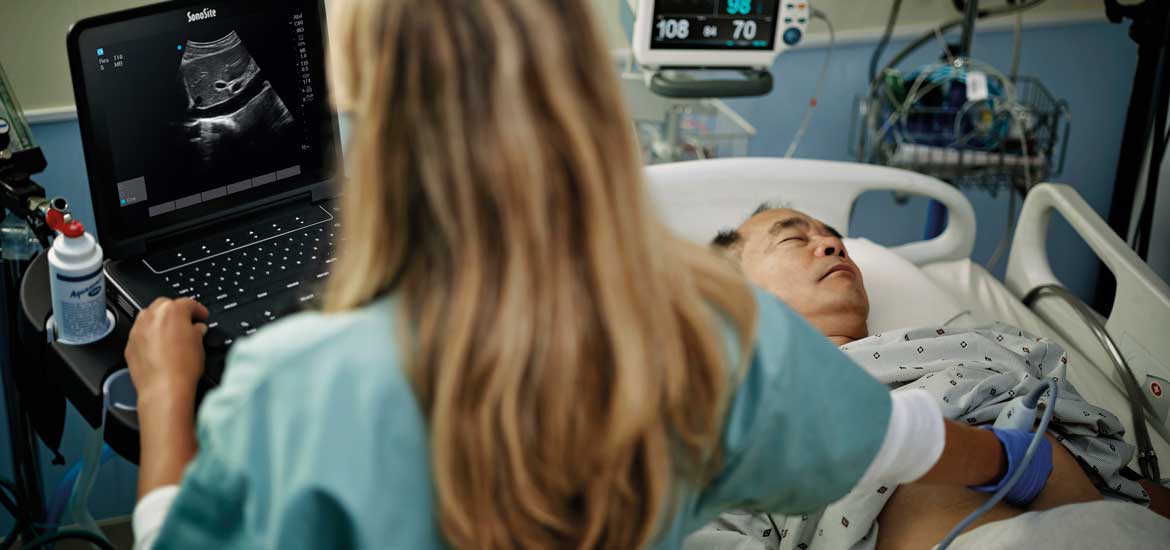Point-of-Care Ultrasound is Essential in Providing Quality Patient Care
Nurses, who are often times a patient’s first-line of care, are now using point-of-care ultrasound* to ensure their patients have the best, most efficient, care possible. Helping to improve patient care, efficiency of procedures, and reduce complications, point-of-care ultrasound in nursing may be used for a variety of diagnostic and procedural guidance applications. The use of ultrasound in nursing is rapidly evolving and improving because it is cost effective, improves efficiency of procedures and is non-invasive.
Reduce complications and improve efficiency by using ultrasound for these applications:
- Peripheral intravenous (PIV)
Reduce the number of attempts and supplies used when vessels are difficult to locate, improve patient experience, avoid complications and the need for central venous lines (CVC), and eliminate delays. See how to perform an ultrasound-guided PIV Insertion now. - Arterial lines and arterial blood gases
Improve success rate, efficiency, and safety for arterial puncture and blood sampling or when patient’s pulse is difficult to palpate - Diagnostic bladder scanning
Reduce cost, and lower the risk of infection from unneeded urethral catheterization by scanning the bladder for residual urine - Limited OB-GYN examinations
Improve efficiency in an obstetric or gynecologic healthcare setting. Perform limited ultrasound diagnostics to confirm fetal heart activity or fetal presentation - Cardiac/volume status
Assess cardiac volume status in heart failure or sepsis patients quickly by looking at pleural cavities and the inferior vena cava (IVC)
*Medical scope of practice can vary by state and/or local jurisdiction.
Millions Saved, Fewer Pokes with POCUS-Guided PIV
Watch how St. Joseph's Heath Care System is using ultrasound to reduce the number of sticks necessary to place a peripheral IV.
Related Articles
- Need to Purchase Imaging Equipment? Consider All Costs of Ownership.
- Ultrasound-Guided Vascular Access Program Saves St. Joseph's $3.5 Million
- Hospitals Must Integrate Imaging Technology to Avoid Cuts to Medicare Payments
- MedPAC and What We Can Learn Regarding the Use of Ultrasound to Guide Procedures
- Ultrasound Helps Reduce a $373 Million-Dollar Risk: Medicare Penalties for Hospital Errors
- Six Steps to Implement Bedside Ultrasonography in Critical Care
- Ultrasound-Guided Procedures: Financial and Safety Benefits
- Smarter Use of Imaging Technology: Reduce Errors Costs
- $330 Million Risk: What Boards Should Know
- A Proposed Payment Differential Policy that Negatively Impacts Hospitals and Potentially Patient Care
- Ultrasound Guidance at the Point of Care
- Why the ultrasound-guided approach to central vein catheterization is replacing the landmark method.
- Emergency Ultrasound at the Bedside: Not Just FAST A Cost-Effective Technology to Reduce Medical Errors and Improve Safety
- Improving Safety and Quality with Best Practices: Focus on Central Venous Access
- Imaging Economics
- Our Journey to Zero Patient Harm
- Pathways That Deliver Increased Physician Efficiency And Improved Patient Satisfaction


